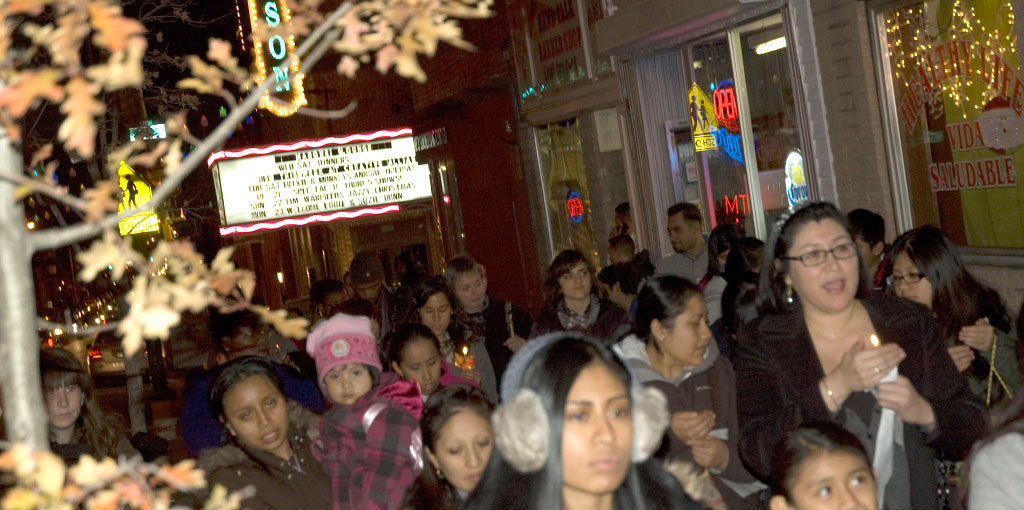In Highlandtown, they take piñatas seriously. Since the papier-mâché vessels of sweetness are part of a centuries-old tradition, perhaps they should.
ProcessionOn Dec. 20, over 100 people walked in a procession from the Creative Alliance at Eastern and East avenues to Sacred Heart of Jesus Church, four blocks over and one block south, at Fleet and Conkling streets. Along the way, they banged on a couple doors, looking for a warm place to stay. In a lyrical, call-and-response dialog, the innkeepers replied that they had no available rooms, and the travelers marched on.
It’s a familiar story, the journey of Mary and Joseph through Bethlehem, looking for a place for Mary to have her baby. What does it have to do with piñatas? To Highlandtown’s Latino community, plenty.
“This is the time when you see piñatas everywhere in the streets of Mexico,” said Maria Guadalupe Lopez at a mid-December piñata-making workshop at the Creative Alliance, where she helped community members use papier-mâché, paste, colorful paper and decorations to fashion their own piñatas.
Pinata making 1Lopez, who is from Mexico City, explained that the procession—or posada—is traditionally followed by a piñata-breaking party. While Highlandtown had one posada, there are typically nine such events in Mexico. That’s a lot of partying, but for Lopez, it’s no problem.
“Sometimes, when it’s a weekend, it’s better to have an even bigger party,” she laughed.
Breaking the piñatas is a symbol of good triumphing over evil. The piñata itself is evil—traditional versions sport seven cones representing the Seven Deadly Sins. The swinging club, which eventually vanquishes evil, represents faith. True faith is blind, so the clubber wears a blindfold.
And the candy?
“It’s all the treats from God,” said Lopez. smash it 2
“It’s so funny,” commented Maria Aldana, “because when I look at so many traditions, they’re all connected to religion—like religion is keeping them alive.”
Aldana, outreach coordinator for the Creative Alliance, rediscovered the Christmas piñata tradition and facilitated its reanimation in Highlandtown this holiday season.
Charged with bringing the community together through group art projects, Aldana was looking specifically for folk art. At Día del Niño, a children’s celebration in Patterson Park, she met members of Mis Raices (My Roots), a Latino mothers’ group from Patterson Park Public Charter School, a preK-grade 8 school at Baltimore St. and Lakewood Ave. Specifically, local artist and mother Rosa Vasquez revealed the piñata tradition to Aldana.
“She’s so joyful and so humble when she works,” Aldana said. “I wondered where all the piñatas came from. I found out they were all handmade in southeast Baltimore.”
Aldana decided that the tradition should be shared with all of southeast Baltimore, not just the Latino community. Cliff Murphy, director of Maryland Traditions—a division of the State Council for the Arts—agreed, a grant was granted, and “Piñatas Navideñas y Posada” was born.
The program included three piñata-making workshops, including one children’s workshop, as well as the Dec. 20 procession through the streets of Highlandtown.
“We come together tonight remembering that there are many people looking for room at the inn,” said Rev. Robert Wojtek, pastor of Sacred Heart Church, at the conclusion of the procession. “We are challenged to open our hearts, our minds and our hands to help them.”
With proper respects paid to the solemn part of the evening, the 100-or-so neighborhood participants sat down to a home-cooked meal.
“A lot of people brought food; it’s really a party made by everybody,” commented Lopez, adding that she hopes America will continue to embrace Latino traditions.
“We are a people that has lots of love and faith, and we want to just mingle,” she said.


